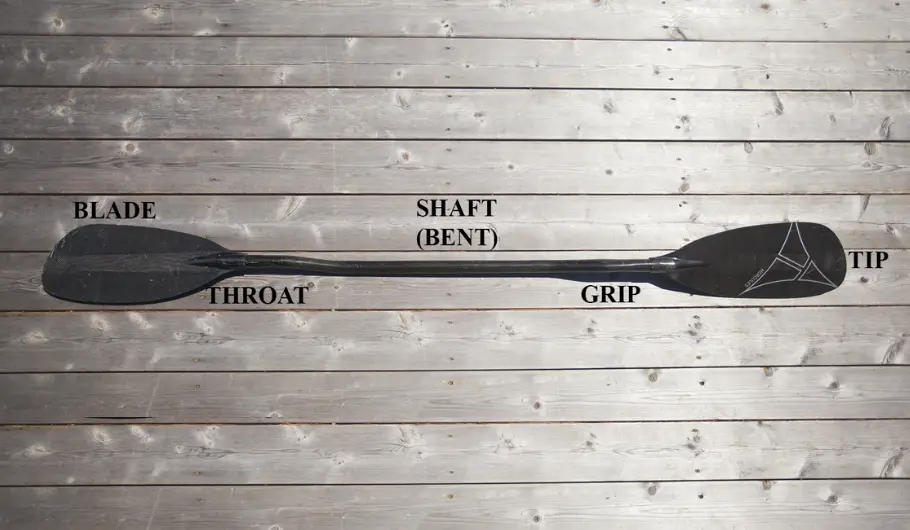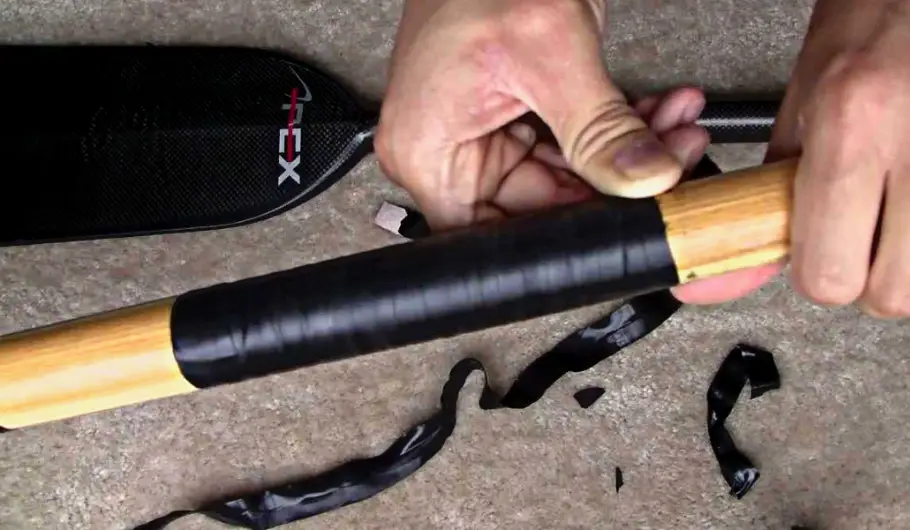Grip tape for paddles sounds like a relatively advanced piece of equipment. Still, it can be a lifesaver, especially for beginners or sporadic kayakers.
Basically, your ideal kayak paddle is the one that feels best in your hands.
This is where grip tape for paddles comes in handy for every skill level.
Grip tape is designed to be wrapped around your kayak paddle shafts to improve grip and friction; they usually go over the part that you grip.
Table of Contents
What Is Grip Tape For Paddles?
Grip tape for paddles not only improves the grip of your paddle but also prevents blisters, keeps your hands warm, and makes your kayak paddle more durable.
Kayak paddles consist of several different parts:

You can disassemble dismountable paddles into these parts and put back together before a tour.
You apply kayak paddle grips or grip tape to the shaft near the throat on both sides – that’s where you hold on with your hands. Doing this provides you with extra grip; it also reduces friction and blisters, and cushion your hands for more comfortable paddling.
There are many makeshift solutions: bicycle handles, tennis racket grips, regular electrical tape, ice hockey stick tape, heat-shrink tubing, you name it! Some people swear by surfboard wax or even lightly sanding the shaft where you hold it.
However, a good grip tape for paddles has unbeatable advantages in material, application, and practicality.
Why Is Grip Tape For Paddles Needed?
In short, paddle grip increases the efficiency of your paddling.
Especially on longer or frequent kayak trips; long paddling can tire your hands and cause blisters on your skin.
Check out our post on fishing kayaks and what you need to know before the trip.
A wet paddle may slip out of your hands. You may even have to tighten your grip so much that your knuckles turn white.
Discomfort is not your friend if you want to enjoy a nice kayak trip. That’s what the grip tape for paddles is for.

How Do You Tape A Paddle Correctly?
Here’s how you apply the grip tape to the paddle shaft:
- Make sure the paddle shaft is clean, grease-free and dry before you begin with the application.
- Most grip tapes have a clear film on one side to prevent the tape from sticking to itself.
- Hold the tape on the paddle as you unwind it and peel off the clear film.
- Wrap the tape around the shaft a few times to ensure a firm hold.
- Begin wrapping the tape in a spiral around the shaft, overlapping the previous layer evenly by half with each wrap.
- For added security, apply at least 2 layers.
A length of 5 feet of tape should be sufficient for one layer on one side of the paddle. So for a double layer on both sides, you should have about 20 feet of tape.

Have a canine friend you want to go on adventures with? Check out our post on kayaking with dogs.
5 Best Grip Tape for Paddles You Can Buy
Comfortable and affordable anti-slip grip tape made of weatherproof silicone. Waterproof and quick-drying. Withstands freezing and hot temperatures. Prevents blistering and improves handling. Works with any shaft diameter.
1.7mm thick, 5mm wide, available in a variety of colors.
This is the number 1 choice on the market of grip tape for paddles. Specifically created for water sports. Made of silicone for superior performance. Available in several colors. 36 inches of tape per roll (can wrap about 10 inches of the paddle.) Burnwater’s promise: Once placed, you never need to change the tape!
Another silicone grip tape – great for a non-slip grip with a touch of padding. Self-fusing so there will be no residual adhesive on the paddle shaft if you remove the tape. Sweat and water-resistant.
Perfect for kayak, canoe, and dragon boat paddles. Each roll is 1″ wide and 78″ (2 meters) long and is enough for applying on 2-3 paddles. This tape will stick to itself, so there is no glue or sticky adhesive. Hornet offers a 100% satisfaction guarantee.
This tape is not specifically for water sports, but it checks all boxes nevertheless. It’s made of silicone, resistant to weather, high temps, chemicals, and saltwater. As a self-fusing tape, it doesn’t use adhesive and is easy to remove.
What Are The Alternatives to Grip Tape For Paddles?
Apart from the aforementioned makeshift solutions such as bike handlebar grips and electrical shrink tubing, you can also try some professional alternatives.
Paddle Grips
Paddle grips are padded and designed to fit your hands while paddling Different sizes and shapes assure the best possible fit. Some are even attachable to your hand with an additional strip. Materials such as neoprene can help to provide more insulation to keep your hands warmer in cold weather.

Paddling Gloves
Many paddling gloves are made of neoprene. This makes them waterproof and insulating, similar to a diving suit. They are very grippy and keep your hands nice and warm! In addition to a comfortable grip without blisters, you’ll be able to have a longer tour without freezing your fingers off.

Pogies
Pogies give you a better feel and control of your paddle than gloves; they are mittens that attach to the paddle and allow a bare-handed grip on the paddle shaft. They wrap around your hands to keep them warm. Think of them as little sleeping bags for your hands.

Paddle Wax
Paddle wax prevents wet or sweaty hands from slipping off the paddle because the moisture simply pearls off. This reduces fatigue and increases performance.
A thin layer on the affected areas before the tour and occasional re-waxing on longer tours provide sufficient protection for the whole day.

A natural alternative without additives is lanolin, obtained from sheep’s wool (therefore sadly not vegan). Its special feature is that it protects the fingers with a water-repellent and very durable film, completely preventing the formation of blisters.
Pro-tip: You can use surfboard or SUP wax directly onto the paddle shaft for better grip!
Want to learn how to safely lock your kayak to your roof racks? Check out this article.
Things To Remember About Grip Tape For Paddles
Various Uses
Grip tape for paddles will improve the grip but add even more to your comfort while paddling.
- Size: If you bought your paddle second-hand or simply miscalculated the right diameter for your hands, paddling can become quite annoying. With every stroke, a too-small diameter will cause the paddle to spin or slip out of your hand. Some people use multiple layers of grip tape to increase the diameter of their paddle.
- Position: If you keep moving your hands closer, making paddling less efficient and maybe even causing back & shoulder pain. A different material might help you keep your hands where they should be without having to constantly look.
Material Durability
Since the tape comes into contact with water, you may need to change it from time to time. But the higher quality the tape is, the less you have to worry about it.
First, pay attention to the material of the grip tape. Most grip tapes these days are made of silicone.
Silicone is by far the best material for grip tapes, as it provides maximum grip and keeps your hands blister-free. It’s also very durable, weather and UV resistant.
Silicone grip tape is perfect for kayaking, as water and dirt can wear out conventional straps.
Changing Paddles
Even with grip tape, you can get blisters in the beginning! Either way, the skin has to get used to repetitive motion, and the hands have to develop calluses.
If you’re constantly changing paddles to avoid blisters, you’re not doing yourself any favors. You’re not giving your hands a chance to get used to the particular shaft.
In general, don’t keep changing your paddle. Get a good paddle and get used to it! The more you paddle with it, the better and faster you will get!
Final Thoughts
Kayaking is a fantastic way to spend a relaxing day and mentally unwind while you’re on the move.
However, to really get the most out of kayaking, you need the right equipment. In addition to a solid kayak that fits your needs, you want to have a paddle that allows you to paddle fast without your hands getting tired too quickly.
Wrapping grip tape around your kayak paddle is so easy that you can’t really get it wrong more than once. Just kidding, it really is as simple as anything! But you will thank yourself for using it!
